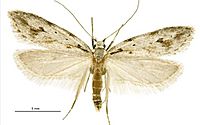Izatha psychra facts for kids
Quick facts for kids Izatha psychra |
|
|---|---|
 |
|
| Conservation status | |
 Nationally Endangered (NZ TCS) |
|
| Scientific classification | |
| Kingdom: | |
| Phylum: | |
| Class: | |
| Order: | |
| Family: |
Oecophoridae
|
| Genus: | |
| Species: |
I. psychra
|
| Binomial name | |
| Izatha psychra (Meyrick, 1883)
|
|
| Synonyms | |
|
|
The Izatha psychra is a special kind of moth that belongs to the Oecophoridae family. This moth is only found in New Zealand, meaning it's endemic there. It's considered a very rare and endangered species by the Department of Conservation.
In 2020, people worried this moth might have disappeared forever after a big fire at the Pukaki Scientific Reserve. This reserve was the only place where the moth was known to live. But good news came in 2021! A survey found I. psychra still living in a small part of the reserve that the fire didn't reach.
Contents
How the Moth Got Its Name
This moth was first described in 1884 by a scientist named Edward Meyrick. He gave it the name Aochleta psychra. He studied a male moth collected by John Davies Enys at a place called Porters Pass.
The original moth specimen that Meyrick used is kept safe at the Natural History Museum, London. Later, in 1988, another scientist named John S. Dugdale moved this moth to the Izatha group, which is its current genus. Scientists still don't know what the young moths (larvae) look like, or what the female moths look like.
What the Moth Looks Like
The Izatha psychra moth is about 21 millimeters long, which is a little less than an inch. Its head and body are mostly grey-whitish with some darker grey spots. Its wings are long and slightly wider at the end. They are whitish with grey and dark brown spots.
It has tiny black dots on its wings. One dot is near the middle, and another small black spot is closer to the wing's edge. It can sometimes be mistaken for other grey moths from a group called Tingena. However, you can tell I. psychra apart because it doesn't have special comb-like parts on its antennae, which Tingena moths do.
Where the Moth Lives
This moth is only found in New Zealand. Specifically, it has only been seen in the southern part of the South Island. The I. psychra moth is known from just two places. One is Porters Pass, where it was first found, but it hasn't been seen there since the 1800s. The other place is the small Pukaki Scientific Reserve near Lake Pukaki in the Mackenzie Basin.
Moth Life and Home
Adult male Izatha psychra moths are usually seen flying around from January to February. In the Pukaki Scientific Reserve, where these moths live, their home is a type of land covered in shrubs.
As mentioned, a big fire in August 2020 badly damaged this reserve. For a while, everyone was afraid the moth might have died out completely. But a survey in 2021 found two adult male moths! This was great news, showing that the species is still alive.
What the Moth Eats
Scientists don't know exactly what the young moths (larvae) eat. However, they believe the larvae probably feed on dead wood.
Protecting the Moth
Even though the Pukaki Scientific Reserve is a protected area, the moth's home is still in danger. It faces threats from wilding pines (trees that spread too much) and fires. Because of these dangers, the Izatha psychra moth is listed as "Nationally Endangered" under the New Zealand Threat Classification System.
As of May 2021, people are working hard to protect the moth's habitat. They are trying to help the reserve recover after the big fire in August 2020.

